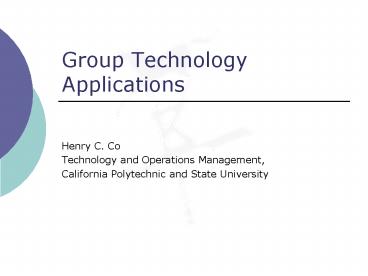Group Technology Applications - PowerPoint PPT Presentation
1 / 17
Title:
Group Technology Applications
Description:
... (CAPP) increases the process planner's productivity and improves the accuracy ... computerization allows the process planner to quickly evaluate alternative plans. ... – PowerPoint PPT presentation
Number of Views:931
Avg rating:5.0/5.0
Title: Group Technology Applications
1
Group Technology Applications
- Henry C. Co
- Technology and Operations Management,
- California Polytechnic and State University
2
Group Technology Layout
3
Traditional Layout Types
4
(No Transcript)
5
GT Layout
- Layout the manufacturing facilities into
manufacturing cells. - Each cell is designed to produce a family of
parts that require similar machinery, tooling,
machine operations, and/or jigs and fixtures. - The routing is greatly simplified by assigning
each family of parts to a cell.
6
GT Layout Benefits
- Implied reduction of necessary control.
- Reduced material handling.
- Reduced set-up time.
- Reduced tooling.
- Reduced in-process inventory.
- Reduced expediting.
- Increase operator expertise.
- Improved human relations.
7
Limitations
- GT layout are not without limits. Since machines
are not shared between cells, more units of
machines are needed for the equivalent capacity
in a functional layout. - Also, not all machines can be grouped into cells.
Typically, 30 to 40 of the total facility can
not be included in any cell and are placed in a
remainder cell. Parts produced in this remainder
cell still have jumbled routings.
8
Computer-aided Process Planning
9
Process Planning
- A process plan establishes the machining process
and parameters to be used (as well as those
machines capable of performing these processes)
in order to convert a work piece from its initial
form to a pre-determined final form.
10
Process Planning
- Computer-aided process planning (CAPP) increases
the process planner's productivity and improves
the accuracy of the resulting plan. - Accuracy is increased because the new plan is
assembled from pieces of information contained in
already existing plans, which have been tested in
actual production. Moreover, computerization
allows the process planner to quickly evaluate
alternative plans.
11
(No Transcript)
12
(No Transcript)
13
Variant Process Planning
- Two approaches to computer-aided process
planning. - The variant approach and.
- The generative approach.
14
Variant Process Planning
- The most common approach is variant process
planning, which applies group technology. - Parts requiring similar processes are grouped
into families, and a standard plan is created for
each family. - The standard plan lists the processes common to
all parts belonging to the same family. - When planning for a new part, the standard
process plan for the family to which the part
belongs is retrieved. - Then, using a "same as-except for" technique, the
standard plan is made specific for the part in
question.
15
Classification Coding
16
Generative Process Planning
- The generative approach uses decision rules for
the selection of processes, tools, etc. - Based on these decision rules, the system
generates the sequence of operations, selects the
most suitable machine tool for the process, and
optimizes the machining parameters.
17
Generative Process Planning
- Generative process planning is just beginning to
be implemented in practice. - The development of better 3-D representation of
solid objects in CAD, and advancements in
artificial intelligence will greatly encourage
its more universal adoption, although much work
remains to be done on the logic of process
planning based on 3-D representation.

